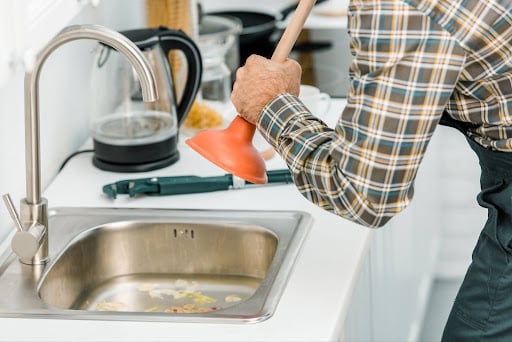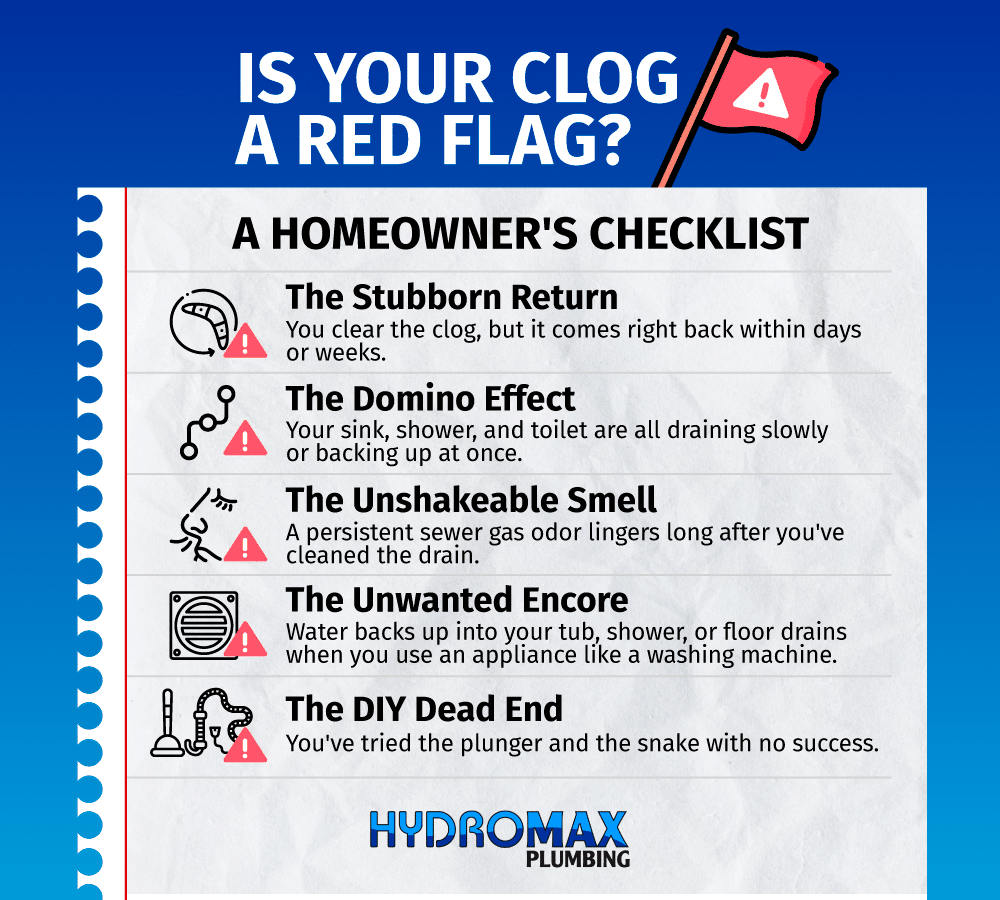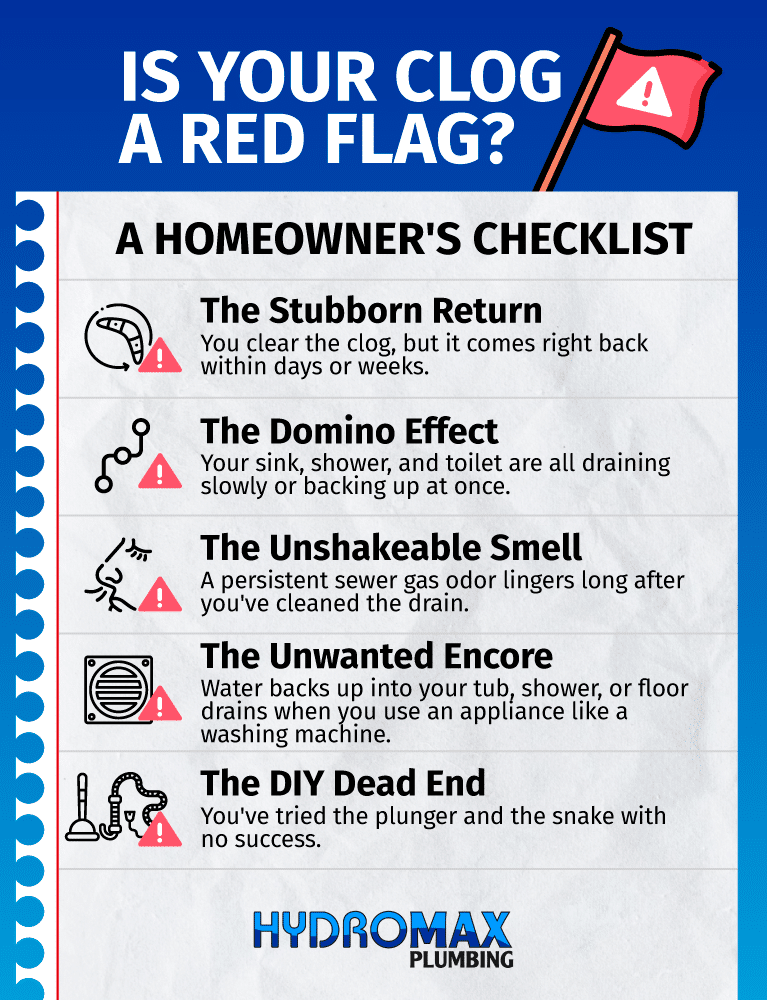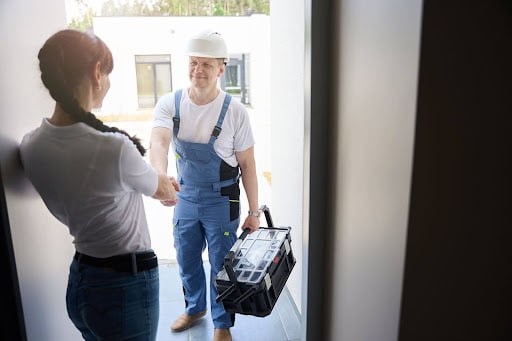
There’s nothing more disruptive than a slow or completely clogged drain. It brings your daily routine to a halt and often signals the threat of messy, expensive plumbing repairs. But what if you could handle most issues yourself and know exactly when to call for backup?
This comprehensive handbook is your guide to everything drain cleaning. We’ll walk you through proactive strategies to prevent clogs from ever forming, safe and effective DIY techniques for minor blockages, and the critical red flags that mean it’s time to call a professional. Let’s dive in and empower you to keep your home’s plumbing running smoothly.
A clogged drain is one of the most disruptive plumbing problems a homeowner can face. While frustrating, most blockages are preventable. The key is to understand what causes clogs in different drains—from the kitchen to the bathroom—and to adopt simple, targeted habits to stop them before they start. This guide pairs the most common culprits with their effective solutions to help you maintain a clear and efficient plumbing system.
While they may be liquid when hot, grease, fats, and oils quickly cool and solidify inside your pipes. This sticky residue acts like a magnet, trapping food particles and other debris until a stubborn blockage forms.
In showers, tubs, and bathroom sinks, shed hair inevitably mixes with soap residue to form dense, net-like clogs that are highly effective at blocking water flow.
Even homes with a garbage disposal are at risk from certain food items. Fibrous vegetables (like celery stalks), starchy foods (like pasta and potato peels), and eggshells can accumulate and create blockages. Coffee grounds are particularly notorious, as they don’t dissolve and can pack together like dense, wet sand.
Many household products are mistakenly flushed down the toilet. Items like wet wipes (even those labeled “flushable”), paper towels, cotton swabs, dental floss, and sanitary products do not break down in water the way toilet paper does. They are a leading cause of severe clogs and can damage septic systems.
Exterior drains are vulnerable to blockages from leaves, dirt, twigs, and other yard waste. More seriously, tree roots can be drawn to the moisture in underground pipes, infiltrating small cracks and growing into massive, pipe-choking obstructions.
By making these preventative measures part of your routine, you can avoid most clogs and the costly repairs that follow. For persistent or severe drain issues, consider establishing a Service Contract to stay on top of your home’s plumbing health.
For minor clogs, start with these gentle and effective methods.


A DIY approach has its limits. Continuing to try and fix a serious blockage on your own can cause more harm than good. If you encounter any of the following red flags, it’s a clear sign that you need professional intervention.
If your DIY attempts are unsuccessful or you recognize any of these warning signs, stepping back is the smartest move. Professional plumbers have the expertise and technology to diagnose the root cause and provide a lasting solution without risking damage to your home.

Specialized professionals use advanced diagnostics and tools to accurately locate and eliminate blockages:
Expert plumbers provide lasting solutions designed to prevent recurring issues. This professional approach can save you time, money, and stress when simple DIY methods are insufficient.
For those facing persistent clogs or complex plumbing challenges, selecting a reputable service provider is crucial. Hydromax Plumbing, based in Evansville, Indiana, offers an extensive suite of plumbing solutions—from routine drain cleaning to major sewer repairs. Their service portfolio includes advanced technologies such as video camera inspections and hydro jetting, designed to offer comprehensive, long-term solutions.
Hydromax Plumbing’s team of licensed and insured professionals is dedicated to delivering reliable service and ensuring lasting results. Their advanced tools and techniques help pinpoint issues accurately and resolve them efficiently, providing peace of mind for homeowners facing difficult plumbing problems.

Drains require consistent care to remain in optimal condition. In addition to practicing good habits, consider these additional preventive measures:
Regular professional checkups can identify minor issues before they escalate, potentially saving you from costly repairs later. Homeowners with older plumbing systems or heavy usage should consider annual inspections.
Many professional plumbing companies, including Hydromax Plumbing, offer service contracts that cover essential maintenance and provide priority assistance when needed. Such a plan helps minimize emergency situations and spreads out repair costs over time.
Maintaining these practices will help you avoid emergency repairs and keep your plumbing system operating efficiently. Whether utilizing DIY methods or professional services, attentiveness and regular maintenance are key to long-term drain health.
A well-maintained drainage system is vital for a smooth-running home. Understanding the causes of clogs and applying appropriate cleaning techniques can help you manage minor blockages effectively. However, persistent issues—such as recurring smells, slow drains, or multiple drains backing up—indicate that it may be time to seek professional assistance.
Hydromax Plumbing is equipped to handle everything from routine drain cleaning to diagnosing and resolving complex plumbing issues with advanced tools and expertise. By combining regular maintenance with professional insights, you can keep your drains operating smoothly and prevent costly plumbing emergencies. For expert drain cleaning services and reliable long-term solutions, consider reaching out to Hydromax Plumbing.